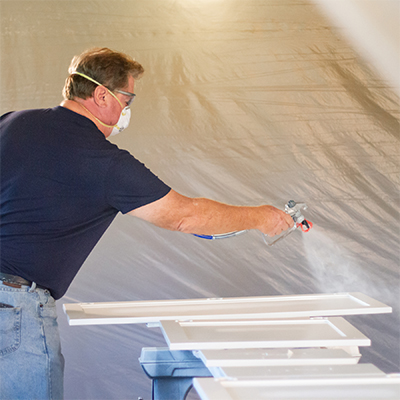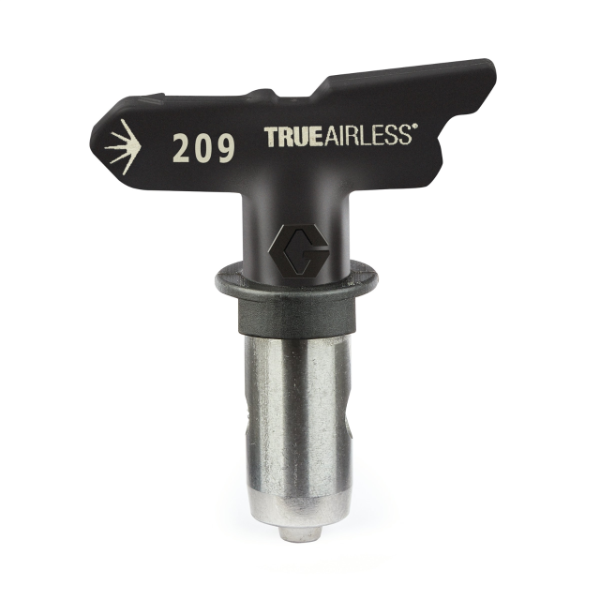HOW TO USE A PAINT SPRAYER FOR DOORS AND TRIM
Project overview
Painting trim and doors in a room can often be overlooked. A new or updated paint colour can put the finishing touch on an interior painting project. A paint sprayer for doors and trim is one of the best ways to eliminate brush marks and evenly coat surfaces resulting in a professional finish. Learn how to paint doors and stain trim with this simple guide.
Safety notice: Whenever operating spray equipment, take proper safety precautions, stay alert, and be mindful of potential hazards. Wear protective gear such as gloves, safety glasses/goggles, spray sock (hood), hat, proper footwear, dust masks and respirators. Make sure there is adequate ventilation. If you’re painting in the vicinity of appliances, turn them off. (See Safety Precautions in your Sprayer Operation Manual) Always refer to the specific instructions and safety procedures for the spray equipment you are using.

WATCH: How to Spray Small Projects (3:12)
Suggested tools & equipment
- Magnum by Graco Paint Sprayer (visit Paint Sprayer category page to compare models)
- Paint/Stain
- Spray tips – a narrow 6- (15 cm) or 8-inch (20 cm) spray fan typically works best
- Empty buckets for priming sprayer and cleanup (two needed)
- Stir sticks
- Paint strainer bag if available – helps prevent tip plugs and provides a better finish
- Tarps, drop cloths, or plastic sheeting
- Masking tape
- Paint brush for touch-ups
- Magnum tip extension (optional) – for hard-to-reach areas that would otherwise require a ladder
- Additional airless hose sections if needed
- Pump Armor storage fluid (see pump protectant product details)
- Cleaning rags
- Stiff nylon brushes for cleanup
- Safety and protection equipment – safety glasses/goggles, dust mask/respirator, spray sock or hat to cover head
Getting started/prep
- Before you paint doors or trim, move as much of the furniture out of the room as possible. Move any remaining furniture to the centre of the room and cover it completely. Allow plenty of space for your tools and equipment.
- Apply masking tape and protective paper around the trim’s edges to protect wall surfaces. Cover all floor surfaces that are near or under the trim and door.
- Remove the door and place it across two sawhorses or a table. Remove all the door hardware.
- Check for cracks or holes in doors or trim. Fill with putty as needed, and then sand any rough areas.
- Thoroughly wipe clean all the trim and door surfaces and allow them to dry thoroughly. To increase paint adhesion, lightly sand the surface with fine sandpaper; then wipe again to remove dust.
Spraying trim & doors
- Select the spray tip that’s best suited for the paint or stain you are using and the surface to be sprayed. Be sure the tip’s hole size does not exceed the maximum capacity of your sprayer (see manual).
- If you’re using paint from multiple containers, mix it together in an empty 10-litre container to ensure consistent colour even if small colour differences exist between individual paint cans. When spraying lighter materials like stains, select the lowest pressure setting that enables you to maintain a good spray pattern. Lower pressure settings will give you better control and a finer finish.
- If your project involves painting the room's interior walls it is recommended to paint trim first.
- Spray the trim in long, even strokes, keeping the tip about 12 inches (30 cm) from the surface you’re spraying. For doors, overlap each successive spray pass by approximately 50%.
Watch the spray techniques video for more spraying pointers.
Clean-up
- Allow significant time for the paint/stain to dry before removing tape from your trim. This will result in crisp, clean lines.
- Remove all coverings from furniture and other areas.
- Replace any hardware that you’ve removed and rehang any doors.
- Clean your airless paint sprayer after each use. Follow the directions in your user’s manual for Power Flush cleaning with water-based materials or use the bucket method of cleaning if applicable. For more information, refer to your Sprayer Operation Manual.
Looking for more videos to watch?
Check out our Education Centre with videos that cover product preparation, start-up and clean-up tips, spraying advice, troubleshooting and much more.
Related Projects
Ceilings
Learn how to use paint sprayers for walls and ceilings with this easy to follow guide from Magnum by Graco. Airless sprayers save time and preserve texture.
Interior rooms
Learn how to use a paint sprayer for interior walls with this guide. Magnum by Graco makes painting a room easy with paint sprayers made to be used inside.
Railings
Discover Magnum by Graco's tips to paint banisters and stair railings using high quality paint sprayers. Protect your railings from sun and weather.
Related projects
Ceilings
Learn how to use paint sprayers for walls and ceilings with this easy to follow guide from Magnum by Graco. Airless sprayers save time and preserve texture.
Interior rooms
Learn how to use a paint sprayer for interior walls with this guide. Magnum by Graco makes painting a room easy with paint sprayers made to be used inside.
Railings
Discover Magnum by Graco's tips to paint banisters and stair railings using high quality paint sprayers. Protect your railings from sun and weather.
Do you have any product questions?
Register your unit
Register your product and receive a free bottle of Pump Armor, a storage fluid that extends the life of your pump.












